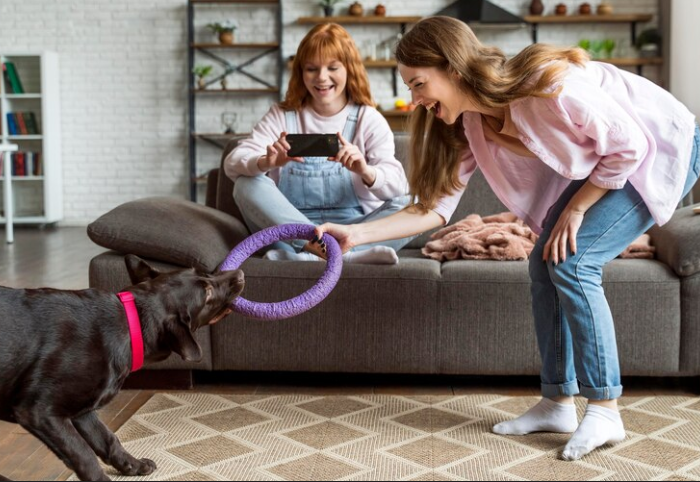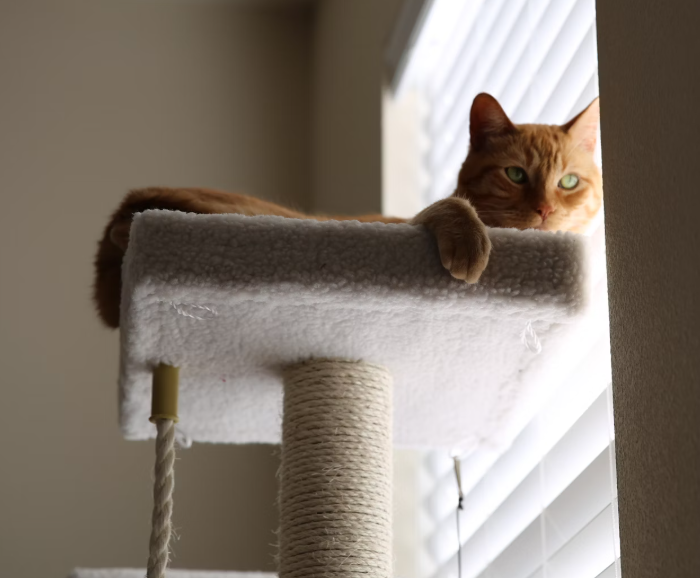2025-05-09
Spending more time indoors with your pet can be a great way to strengthen your bond and get to know each other better. However, just like people, dogs and cats can also become bored, restless, or even stressed if their environment doesn’t meet their needs.
This highlights the importance of creating a space that keeps them mentally and physically stimulated. Providing a safe, but also engaging environment for your beloved furry friend can make a big difference not only in their happiness but in yours as well.
In today’s article, we will provide some insights into the essential role of a good indoor living environment and give practical tips to help you create the best conditions for your dog or cat!

Let’s start by clearing up the idea that keeping your furry companion happy indoors is just about avoiding boredom. Their physical and mental stimulation at home plays a big role in their overall health and behavior.
A mentally and physically engaged pet is less likely to develop anxiety, destructive behaviors, or weight issues associated with a sedentary lifestyle. Furthermore, indoor enrichment becomes especially important during bad weather, when recovering from illness or injury, or if you live in an apartment or area where outdoor time is limited.
It’s also valuable for senior pets who may not get around as easily or for households, where going outside isn’t always safe. Building a fulfilling indoor environment gives our paw companions the stability and stimulation they need, regardless of their lifestyle.

Now that we understand why a good indoor environment matters, let’s take a look at some practical ways to keep your dog or cat happy and thriving inside your home.
Build a Daily Routine
The importance of establishing a routine goes beyond creating a structure- it helps your pet feel more secure and reduces anxiety. Dogs, in particular, thrive on consistency, as they feel more relaxed when they know when to expect meals, walks, and playtime.
For cats, routines can also help reduce stress, especially around feeding and playtime, because they learn to expect when their needs will be taken care of. A solid routine also makes it easier to integrate training and bonding sessions into their daily life. This, in turn, helps reinforce positive behavior and strengthens the relationship with your pet.
Interactive play is a great way to create a bonding experience that strengthens the bond you share with your pet. For dogs, games like fetch or hide-and-seek allow them to use their instincts and energy productively.
If you are a cat parent, you may consider engaging your feline in games that mimic hunting, such as dangling a toy on a string or using puzzle feeders. This type of play helps improve their problem-solving skills and physical coordination.
Engaging play sessions help our furry friends keep their minds sharp and bodies active, and prevent them from exhibiting unwanted behaviors out of boredom.
Enrichment activities don’t involve toys only. They help provide your pet with ways to satisfy their instincts in a safe and controlled way.
Dogs can enjoy activities like scent work or food-dispensing toys that engage their noses and minds, and keep them entertained for longer periods.
Cats, on the other hand, benefit from activities related to scratching posts and climbing shelves, which allow them to engage with their environment more naturally.
These activities help keep your pet's mind active, prevent boredom, and even reduce stress, which is important for their overall well-being.
The term “pet-friendly environment” goes beyond creating a safe space, but one that encourages your pet’s natural behaviors.
For example, dogs often enjoy having a comfortable, designated spot where they can relax without feeling overstimulated.
Both cats and dogs can benefit from areas where they can hide or retreat to when they need a break, especially if you have a busy household or frequent visitors. A designated area, which will be their ‘safe zone’, will contribute to reducing their anxiety and creating a feeling of comfort and safety.
Being able to observe the outside world can be a huge mental boost for pets, especially for cats, who enjoy watching birds, cars, or people pass by.
Setting up a comfortable perch or window seat where they can safely watch the outside world not only satisfies their curiosity (you know how curious felines are) but also provides entertainment and mental stimulation.
Dogs also enjoy observing the outside world, especially if this allows them to keep an eye on people passing by. Giving them a spot to look outside helps them feel connected to what's happening beyond the walls, even if they can't go outside as often as they would like.
Training isn’t just about teaching commands, so don’t skip this point if you think you don’t need to teach your paw friend any commands. Training can be very beneficial as it provides a mental challenge and helps your pet improve their confidence.
It’s important, though, to keep training sessions short (about 5–10 minutes each) and fun! Remember, your furry friend may lose focus quickly, so engaging them in long, boring sessions won’t yield the desired results. Always end the sessions while your dog or cat is still having a good time, as this will help them associate training with something positive they’ll look forward to.
By keeping sessions positive and interactive, you help build a sense of accomplishment in your pet and reinforce good behavior. You may even notice how proud your dog/cat looks after learning a new task!
While some pets are more independent, others crave attention and interaction. With that being said, it’s important to recognize your furry friend’s specific needs. We also advise you to consider not only your pet’s breed characteristics but also their traits, temperament, and requirements. Dogs and cats are individuals, just like us.
Dogs, especially, can be very social and benefit from quality time spent with you, whether it’s through play, cuddling, or just being in the same space.
Cats can also form strong bonds with their human companions (cat parents will confirm that), but they tend to appreciate social interactions in their own way. Some may enjoy sitting next to you, while others might prefer interactive play. Cats can also be more protective of their personal space, so it’s essential to respect their boundaries.
Paying attention to your paw companion’s temperament, personality, and social cues ensures that they get the attention they need to stay happy without feeling overwhelmed or neglected. It will also allow you to tailor activities and routines to meet their individual needs. This ensures they feel both mentally stimulated and emotionally secure in their indoor environment.
To make sure your beloved dog or cat feels happy indoors, you should keep an eye out for signs that they may be feeling stressed or overstimulated.
Dogs may show stress by excessive panting, drooling, or destructive behavior like chewing or digging.
Cats, on the other hand, might retreat to dark corners, groom excessively, or have a decreased appetite.
It’s essential to recognize these signs early, as doing so can help you identify potential issues quickly and address them with simple changes, such as increasing playtime, giving your pet more personal space, or even rearranging their environment.
Keeping your dog or cat mentally and physically engaged can help minimize the chances of stress developing, but being observant also allows you to respond quickly if it does.
Properly taking care of your pet and ensuring they are happy indoors is not just about mental and physical stimulation but also about their overall well-being.
Regular health check-ups are essential to ensure your dog or cat is happy and healthy. Never ignore changes in behavior, such as increased irritability, reluctance to play, lethargy, decreased appetite, or redness and swelling of body parts, as they could be signs of health problems like infections, organ diseases, arthritis, or dental issues.
Vet visits, at-home wellness checks, and keeping an eye on your paw companion’s diet and weight can help prevent issues from escalating. A healthy pet is more likely to be active and happy, so you should make regular health maintenance a key part of their overall well-being.